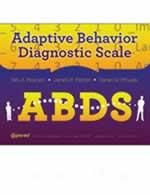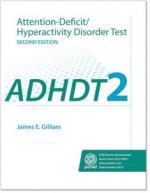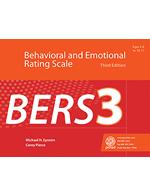ASDS: Asperger Syndrome Diagnostic Scale
Interest Level:
Additional Components:
Test, Manual and Response Forms
This product requires a check of customer qualifications.
CLICK HERE to download qualifications form.
50 yes/no items help you determine whether a child has Asperger Syndrome Testing Time: 10 to 15 minutes Administration: Individual The Asperger Syndrome Diagnostic Scale (ASDS) is a quick, easy-to-use rating scale that can help you determine whether a child has Asperger Syndrome. Anyone who knows the child or youth well can complete this scale. Parents, teachers, siblings, paraeducators, speechlanguage pathologists, psychologists, psychiatrists, and other professionals can...
50 yes/no items help you determine whether a child has Asperger Syndrome
Testing Time: 10 to 15 minutes
Administration: Individual
The Asperger Syndrome Diagnostic Scale (ASDS) is a quick, easy-to-use rating scale that can help you determine whether a child has Asperger Syndrome. Anyone who knows the child or youth well can complete this scale. Parents, teachers, siblings, paraeducators, speechlanguage pathologists, psychologists, psychiatrists, and other professionals can answer the 50 yes/no items in 10 to 15 minutes.
Designed to identify Asperger Syndrome in children ages 5 through 18, this instrument provides an AS Quotient that reveals the likelihood that an individual has Asperger Syndrome. The 50 items that constitute the ASDS were drawn from five specific areas of behavior: cognitive, maladaptive, language, social, and sensorimotor.
Diagnosis of Asperger Syndrome is difficult because the characteristics of the disorder often resemble those of autism, behavior disorders, attention-deficit/hyperactivity disorder, and learning disabilities. The ASDS serves an important function by quickly allowing you to determine whether a child or adolescent is likely to have Asperger Syndrome.
The first test of its kind, the ASDS was normed on 115 persons with Asperger Syndrome from across the United States. The sample ranged in age from 5 to 18. The ASDS meets reliability and validity criteria established by the professional assessment community. Therefore, by comparing an individual¹s score with the normative sample, an examiner can establish the probability that the individual has Asperger Syndrome. Low AS Quotients are indicative of persons with little or no known pathology, whereas higher scores are increasingly more indicative of Asperger Syndrome.
All items included in the ASDS represent behaviors that are symptomatic of Asperger Syndrome, and all are summed to produce the total score. The scores from the five subtests present the examiner with information of clinical interest regarding an individual¹s performance in comparison to that of others with Asperger Syndrome. The total score has strong diagnostic value in identifying individuals with Asperger Syndrome and is the only score to be used when determining the likelihood of Asperger Syndrome. This contributes greatly to ease of administration and cuts down on otherwise time-consuming testing procedures.
The ASDS can be used with confidence to (a) identify persons who have Asperger Syndrome, (b) document behavioral progress as a consequence of special intervention programs, (c) target goals for change and intervention on the student's Individualized Education Program (IEP), and (d) measure Asperger Syndrome for research purposes. Because the ASDS is based on observations, the test results are valid only when the rater knows the examinee well; that is, the examiner has had regular, sustained contact with the examinee for at least 2 weeks.
Raw scores are converted to percentile and standard scores. These scores are the most important information associated with an individual's ASDS performance, and analysis of them, augmented by additional test information, direct information of behavior, and knowledge acquired from other sources, will result in proper diagnosis of Asperger Syndrome.
COMPLETE ASDS KIT INCLUDES: Examiner's Manual and 50 Summary/Response Forms, all in a sturdy storage box. (©2000)
User Qualifications:
To administer this test at least a master’s degree is required, with state licensure OR certification from a professional organization (ASHA, AOTA, APA, AERA, ACA, AMA, NASP, NAN, INS) that requires formal training and experience in ethics, psychometrics, statistics, and scoring and interpretation. Tests of perceptual, academic, and functional processes used in schools, clinics and rehabilitation settings are of this level. “All test users, regardless of level and profession, are expected to abide by the standards set forth by the APA, AERA and NCME regarding the ethical use, protection and dissemination of all test materials. All orders for the products listed below, must be placed on official institutional purchase order forms or professional letterhead.
The purchase of this product requires a check of customer qualifications.
CLICK HERE to download qualifications form.
Orders for items on this page cannot be completed online. Please attach completed qualifications form to your institutional purchase order or professional letterhead when ordering this product. For questions or help placing your order for these items call (800) 880-4433.
To create a requisition form
- Enter a Quantitiy for the item(s) desired
- Click Add to Cart
- Click Print a requisition list
Item #
Products
Price
Wishlist
Qty
Requested quantity is not available at this time
YP1351YY
ASDS: Complete Kit
$160.00
Requested quantity is not available at this time
YP1352YY
ASDS: Examiner's Manual
$89.00
Requested quantity is not available at this time
YP1353YY
ASDS: Summary/Response Forms (50)
$82.00




